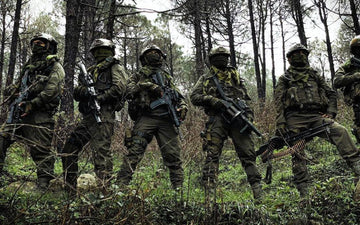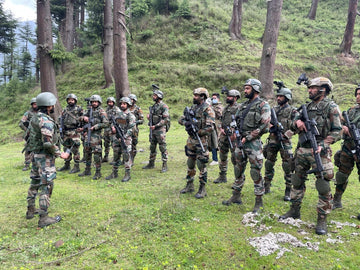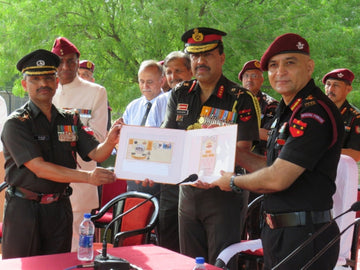The Indian Army has long been revered for its commitment to national security and service. Among its many recruitment initiatives, the Agniveer program has emerged as a pivotal addition, reshaping the landscape of military enlistment in India. Designed to attract a younger, tech-savvy generation, the Agniveer selection process for 2025 is a comprehensive multi-stage assessment that evaluates candidates based on their aptitude, physical fitness, and medical standards. This article delves into the intricacies of the selection process, eligibility criteria, and the significance of the Agniveer program, laying the groundwork for an informed discussion about the future of military enlistment in India.
Historical Context of the Agniveer Program
The Indian Army's Agniveer initiative, launched in 2022, seeks to create a dynamic and agile fighting force while offering a unique opportunity for youth to serve the nation. Historically, military enlistment in India relied heavily on traditional, long-term recruitment practices. The Agniveer program marks a departure from these norms, introducing a shorter service term of four years for young recruits. This strategy not only revitalizes the military's ranks but also enables future career opportunities for participants upon their completion of service. The conception of Agniveer aligns with India’s broader goal of modernizing its defence forces amid rapidly changing global dynamics.
Detailed Overview of the Agniveer Selection Process
The selection process for Agniveers is designed to be rigorous, ensuring that only those who meet the respective educational, physical, and psychological requirements can serve. Broadly, this process is divided into two main phases: the Online Computer-Based Test (CEE) and the Recruitment Rally. Each phase serves a distinct purpose in evaluating candidates.
Phase I: Online Computer-Based Test (CEE)
The first step of the selection process is the Common Entrance Examination (CEE), scheduled from June 30 to July 10, 2025. This online assessment is tailored to gauge a candidate's general knowledge, reasoning ability, and technical skills pertinent to various roles within the army.
-
Exam Structure and Format
-
Soldier Clerk Exam: This role has two exam patterns depending on specific requirements:
- 50 questions to be completed in one hour, or 100 questions in two hours with a 25% penalty for wrong answers.
- Soldier General Duty (GD) Exam: This includes 100 marks, focusing on General Knowledge, Mathematics, and Logical Reasoning across 50 questions.
- Soldier Technical Exam: This exam consists of 50 technical questions totaling 200 marks, emphasizing specific technical knowledge critical for various positions, alongside a negative marking scheme of one mark for each incorrect answer.
-
Soldier Clerk Exam: This role has two exam patterns depending on specific requirements:
With these structured formats, the CEE aims to provide a comprehensive outlook on candidates' cognitive abilities.
Phase II: Recruitment Rally
Candidates who pass the CEE are eligible to participate in the physical Recruiting Rally. This phase involves multiple assessments aimed at evaluating candidates' physical fitness, medical compliance, and overall adaptability in army environments.
-
Components of the Recruitment Rally
- Physical Fitness Test (PFT): This critical component assesses candidates' strength, stamina, and endurance through rigorous physical activities.
- Physical Measurement Test (PMT): This test ensures candidates meet the predetermined physical standards, considering height, weight, and endurance.
- Adaptability Test: This evaluates how well candidates can adjust to the varied conditions and challenges typical of military life.
- Medical Examination: A thorough medical check-up guarantees that candidates meet the health standards necessary for service.
Success in each component is mandatory to progress, ensuring that only the most competent individuals advance in the selection process.
Eligibility Criteria for Aspiring Agniveers
Eligibility to become an Agniveer is stratified into age and educational qualifications, crucial for maintaining a high standard of selection.
- Age: Candidates must be aged between 17½ to 21 years, allowing the army to recruit youthful individuals who embody vitality and potential.
- Educational Qualifications: Aspiring recruits must have passed the Class 10th/Matriculation examination with a minimum of 45% aggregate marks. Furthermore, candidates should achieve at least 33% in individual subjects, adhering to equivalent grading norms when applicable.
These criteria are essential in receiving a well-rounded cohort of candidates capable of contributing positively to the army's mission.
The Evolving Structure of the Selection Process
During previous recruitment years, the order of tests differed significantly. The introduction of the online CEE as the initial step marks a strategic shift; it allows the Indian Army to filter candidates based on their intellectual capabilities before proceeding to physical assessments. This approach aims to streamline the selection process and yield better-suited candidates for military roles.
Understanding the qualifying marks set for the CEE is critical. This threshold ensures only candidates with a foundational knowledge base proceed to the subsequent rounds, reinforcing the idea that cognitive skills are as crucial as physical prowess in modern military operations.
Challenges and Solutions in the Selection Process
While the Agniveer selection process is designed to be comprehensive, it is not without its set of challenges. One of the primary obstacles is the high level of competition among candidates. With thousands vying for a limited number of positions, maintaining transparency and fairness in the selection process is paramount.
Another challenge is ensuring that candidates remain physically and mentally prepared throughout the rigorous evaluation stages. Many candidates may struggle with the transition from the academic environment to physical assessments.
Proposed Solutions:
- Pre-Training Programs: Implementing pre-selection training workshops can better prepare candidates for both physical and cognitive challenges.
- Awareness Campaigns: Educating potential candidates about the selection process and its demands can alleviate anxiety and improve performance.
By addressing these challenges, the Indian Army can strengthen the relevance and effectiveness of its recruitment process.
Future Trends in Military Recruitment
The Agniveer program is pioneer in the evolution of military recruitment. As the Indian Army adapts to contemporary security demands, several future trends may emerge:
- Increased Utilization of Technology: The integration of AI and analytics in assessing candidates could enhance the selection process.
- Emphasis on Diversity and Inclusion: There may be a growing focus on ensuring a diverse intake of recruits to better reflect India's multifaceted society.
- Career Transition Programs: Preparing Agniveers for civilian careers following their service will become a vital component of recruitment strategy, optimizing the long-term benefits of military service.
Real-world Applications and Case Studies
To draw insights from the Agniveer initiative, it is essential to consider the impact of this recruitment model on both the individual recruits and the broader defense landscape.
Case Study: The First Batch of Agniveers
The initial cohort of Agniveers, inducted in late 2022, revealed significant trends on productivity and mental resilience. Many of these recruits shared testimonies about how the program provided them with skills beyond traditional military training, such as leadership, teamwork, and crisis management. These narratives illustrate the dual benefits of serving as an Agniveer, where the focus is not merely on military efficiency but also on personal development.
Conclusion
The Agniveer selection process for 2025 represents a transformative shift in how the Indian Army recruits and trains its personnel. By adopting a multi-faceted evaluation system that includes a rigorous online examination and demanding physical assessments, the army ensures it selects the most capable candidates.
Emphasizing both educational backgrounds and physical fitness standards aligns with the modern realities of warfare and defense strategy. As this program evolves, it is crucial for prospective Agniveers to prepare thoroughly, understanding not only the challenges but also the unparalleled opportunities it offers.
In conclusion, the future of military recruitment in India is bright, as Agniveer combines a modern ideology with the time-honoured tradition of service to the nation. Aspirants are encouraged to take the initiative, invest their time in preparation resources such as SSBCrack and SSBCrackExams materials, and embrace the chance to serve India with pride. The call to arms is not just a recruitment advertisement; it is an invitation to be a part of something greater than oneself.





